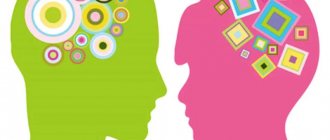Learning
Learning is the process and result of acquiring individual experience. This concept originated in animal psychology (Thorndike). There are many forms of learning characteristic of specific stages of mental development.
In ethology, there are two types of learning:
- obligate (obligatory) learning - the development of species-specific instinctive, vital behavior during training in a certain sensitive period (for example, a species-specific “deadly bite” in cats, “song” in bullfinches, speech and upright walking in humans). The learning result fits well within the framework of the specific behavioral stereotype.
- facultative learning - individual experience of a specific individual, which is not species-specific and vital. The limits within which f. n., differ depending on the evolutionary stage; for humans they are maximum.
According to the degree of participation of the subject, the following forms of learning are distinguished:
- reactive forms of learning (habituation, sensitization, inprinting, classical conditioning).
- active forms of learning (less complex - operant learning, more complex - cognitive learning).
Examples of Fundamentals of Learning
If you think about it, examples of operant learning (operant conditioning) are very common in everyday life: schoolchildren who do homework assignments will receive a reward from their parents in return; employees who, upon achieving a given standard, will receive a salary increase or promotion. These are only those examples that show the prospect of rewards if the task is completed, but learning can also be used to wean a person from the habit by punishment or deprivation of what he wants.
For example, schoolchildren can be discouraged from talking in class, you just need to deprive them of the opportunity to have fun during the expected break.
Available Operant Conditioning Components
Feeding or reinforcement is an uncertain action that can affect the development of the required behavior model.
There are 2 types of recharge:
- Positive operant conditioning is reward, it is used to encourage the desired model of behavior: for example, this could be praise or a desired reward;
- Negative operant conditioning is actions or results that do not bring pleasure, which are stopped for reward when the behavior is achieved.
Both the first and second types of reinforcement are used to encourage the behavior that you want. Punishment is used when it is necessary to stop an unwanted behavior pattern.
In total, there are 2 types of punishments:
- Positive punishment - in this case, an undesirable action is used in order to reduce the subsequent reaction;
- Negative punishment is the cessation of an unwanted action in order to weaken the reaction behind it. Both types are used to reduce unwanted behavior patterns.
Operant conditioning, behavior (behavior that has been caused by learning) can be determined by specific events that usually follow a response. Thus, a certain behavior is followed by a consequence, and the formation of that very consequence replaces the body’s tendency to be reflected by this behavior in the future.
The simplest (instinctive) forms of learning
These forms of learning are accessible to organisms already at the stage of the elementary (sensory) psyche. It is instinctive.
Instinct is an innate (motor!) form of behavior. This is a fairly rigid program, a sequence of elementary movements, each of which occurs in response to a specific environmental influence (i.e., the S–R scheme). The behavioral program inherent in instinct can only be implemented when each link in this chain is executed in the correct sequence.
Habituation is a gradual decrease in response as a result of ongoing or repeated stimulation (and not accompanied by reinforcement).
Unlike habituation, when tired, attention to all stimuli decreases.
Unlike sensory adaptation, habituation is a mental and not a purely physiological process.
Sensitization is the opposite of addiction. With it, repetition of a stimulus leads to stronger activation of the body, and the latter becomes more and more sensitive to this stimulus.
Imprinting (author of the term K. Lorenz) is the “imprinting” of an object of instinctive behavior (for example, with the instinctive reaction of following). Some instinctive behavior is triggered by a “key stimulus,” but this stimulus itself is not specifically determined in advance and depends on existing conditions. The consequences of imprinting are irreversible.
Male greylag and white-fronted goose chicks imprint on their mothers as the female specimen of their species. If female wild duck chicks are exposed to an albino male during the sensitive period, their sexual behavior will subsequently be directed toward albino drakes.
Sequential learning.
Some types of learning require the performance of separate behavioral acts, each of which is easily mastered individually, but then they are combined into a certain sequence. Research on one type of sequential learning, the so-called. serial verbal learning were started by the German philosopher and psychologist G. Ebbinghaus (1850–1909). Ebbinghaus's experiments involved memorizing lists of words or syllables in a specific order and demonstrated for the first time several well-known laws, in particular the law governing the ability to remember elements of a sequence. This law of “place in a series” states that in any sequence the easiest part to remember is the beginning, then the end, and the most difficult part is the part immediately following the middle. The effect of place in a series appears when performing any task of this kind - from memorizing a telephone number to memorizing a poem.
Mastery of a skill is another type of sequential learning, which differs from verbal learning in that a sequence of motor reactions, rather than verbal ones, is learned. Whatever the area of the skill - sports, playing a musical instrument, or tying shoelaces - mastering it almost always involves three stages: 1) instruction, the purpose of which is to determine the task facing the performer and give recommendations on how to perform it; 2) training, in which the required actions are performed under the control of consciousness, at first slowly and with errors, then faster and more correctly; 3) the automatic stage, when behavioral acts proceed smoothly and require less and less conscious control (examples of an automatic skill are tying shoelaces, changing gears in a car, dribbling the ball by an experienced basketball player).
More complex (individual) forms of learning
A skill is an activity formed through repetition and bringing to automatism.
This is a form of optional learning, individual lifetime experience. A skill is formed on the basis of instinctive behavior, but in essence it is individually variable behavior.
Skill properties:
- it is a more flexible and active adaptation to the environment. The skill is built and formed as it progresses, taking into account changing conditions; There are more operations in skill than in instinct (there is only one), and the choice of operation depends on conditions and situations. the skill can be transferred and used in new conditions (this possibility depends on the stage of mental development).
Types of skill-based learning:
- classical conditioning (Pavlov) operant conditioning (Skinner, Thorndike) cognitive learning (Tolman, Koehler, Bandura).
Partial reinforcement.
Instrumental learning using rewards—for example, training a rat in a Skinner box to press a lever for food or praising a child when he says “thank you” and “please”—involves several types of relationships between behavior and reinforcement. The most common type of addiction is constant reinforcement, in which a reward is given for each correct response. Another option is partial reinforcement, which offers reinforcement only for some correct responses, say every third time the desired behavior occurs, or every tenth time, or the first time it occurs every hour or every day. The effects of partial reinforcement are important and of great interest. With partial reinforcement, it takes longer to learn the desired behavior, but the results are much more durable. The persistence of the effect is especially noticeable when the reinforcement is stopped; This procedure is called "extinction". Behavior learned with partial reinforcement persists for a long time, while behavior mastered with constant reinforcement quickly ceases.
Conditioning()
This is a new form of behavior that arises as a result of establishing a connection between innate forms of behavior (unconditioned reflexes) and a new stimulus (conditioned stimulus). As a result of conditioning, a new voluntary stimulus, a conditioned stimulus, can trigger a reflex response if it is presented for some time together with an unconditioned stimulus.
Example. If you let a hungry dog smell meat, it will secrete gastric juice (this is an unconditioned reflex). If, simultaneously with the appearance of meat, a bell rings every time, then the dog’s nervous system associates this sound with food. As a result, gastric juice will be released in response to the call, even if no meat is presented.
The conditioned reflex thus formed can subsequently serve as the basis for the formation of conditioned reflexes of the second and higher orders, as well as integration (the formation of a single complex conditioned reaction based on many simple ones).
In general, conditioning follows the classical behaviorist pattern (S→R). The new behavior is “historically linked” to a known unconditioned stimulus.
Secondary reinforcement.
During associative learning, some signals that initially had no value or did not indicate danger are associated in the mind with events that have value or are associated with danger. If this happens, signals or events that were previously neutral in nature begin to act as rewards or punishments; This process is called secondary reinforcement. A classic example of secondary reinforcement is money. Animals in a Skinner box are ready to press a lever to obtain special tokens that can be exchanged for food, or to cause the bell to ring, with the sound of which they are accustomed to identify the appearance of food. Avoidance learning illustrates a variant of secondary reinforcement through punishment. The animal performs certain actions when a signal appears, which, although not itself unpleasant, constantly accompanies some unpleasant event. For example, a dog that is often beaten cowers and runs away when its owner raises his hand, although there is nothing dangerous in the raised hand itself. When positive and negative secondary reinforcement is used to control behavior, there is no need for frequent actual rewards or punishments. Thus, when animals are trained using the successive approach method, the reinforcement for each attempt is usually only the clicking sound that previously regularly accompanied the appearance of food.
Operant conditioning (B. Skinner, E. Thorndike)
An operant is a way of behavior. “Operants that lead to reinforcement (pleasant consequences for the individual) are more likely to occur in the future” (“Law of Benefit” formulated by Skinner).
Example. A laboratory rat was placed in a “Skinner box” (an empty box with a pedal inside) and given complete freedom of action. During the chaotic exploration of the box, the rat touched the pedal and received a portion of food. After several such random pedal presses, the rat developed a new form of behavior that was not associated with any previous stimuli.
That is, the fundamental difference between operant learning and conditioning is the absence of a direct connection with an unconditioned stimulus. Any behavior can be reinforced. The behavior itself can be either random or imitative.
Reinforcement can be positive (provide a pleasant stimulus) or negative (remove an unpleasant stimulus), and is guaranteed to lead to reinforcement of the behavior it follows.
Punishment can also be positive (give an unpleasant stimulus) or negative (remove a pleasant stimulus), but unlike reinforcement, it leads to unpredictable consequences - for example, to finding ways to avoid punishment and get what you want.
Example. In case of a fine, a person is forced to look for other forms of behavior in order to avoid the fine. It often turns out that these new "workaround" forms of behavior are even less desirable than those that caused the punishment.
A type of operant conditioning is learning by imitation.
There are two forms of imitation:
1) ordinary imitation - imitation without assessing the consequences for oneself.
Example. Japanese macaques and sweet potatoes. The researchers set up their camp near the place where a herd of Japanese macaques lived. Before eating, the researchers washed yams (sweet potatoes) in the river. Soon young male monkeys began to do something similar. Such actions were not necessary for them; it was not aimed at protecting the body or the herd: monkeys can easily eat food without first cleaning and washing it. Then more and more monkeys began to perform similar actions.
2) vicarious imitation (“learning through observation”, “social learning”) - imitation of a model with a partial understanding of the consequences of one’s actions for oneself. andura was that in order to consolidate the reproducibility of the operant, it is enough only to observe whether the object of observation is rewarded or punished for this behavior.
Example 1. Bobo doll. The actor, in the presence of a group of children, mocked and beat the Bobo doll, receiving public praise for this. When the children were then allowed to play alone with Bobo, they behaved similarly aggressively towards her. These aggressive patterns of behavior were reproduced many months later.
Get full text
Example 2. Chips. Children played skittles and, if successful, received chips that they could exchange for very attractive things. An adult (actor) played with them, but each time, without explaining anything, he donated some of the chips (put them in a mug) to a charitable foundation. Pretty soon the children started doing the same. Months later, the children took part in a completely different game, but even then a large number of chips ended up in the charity circle.
Examples of operant conditioning
As an example, consider riding a board, throwing darts , playing the piano, or writing your own name - these are considered examples of operant response, outcomes that can be controlled, following behavior. These are independently acquired reactions; for them there cannot be a stimulus that we could recognize.
Skinner did not deny that it is pointless to talk about the emergence of an operant method of behavior. After all, we cannot know the incentives or internal reasons that are responsible for its appearance. That is, it arose spontaneously.
In cases where the consequences have a positive effect on the body, the likelihood of the operant being repeated in the future will increase. When this happens, any consequences are fueled, and operant conditioning, obtained through reinforcement, is conditioned. The magnitude of the positive reinforcement stimulus is determined according to the effect on the subsequent frequency of the reaction that previously preceded it. Thus, the theory also works in the opposite way, in cases where the response is unfavorable and has no reinforcement, the probability of obtaining the operant is significantly reduced.
Cognitive learning
is learning that occurs as a result of cognitive activity. It is based on the neo-behaviourist scheme of behavior S→O→R, where between stimulus and response there are “internal behavioral variables” (goals; knowledge about conditions, understanding of the task; abilities; adaptive acts that replace real behavior).
Latent (hidden, involuntary) learning (E. Tolman)
Involuntary formation of the so-called. a cognitive map (a holistic perceptual image-scheme of the situation and one’s possible actions in it) as a result of orientation-research activity. Possible for organisms that are at the perceptual stage of mental development (implying an understanding of the connections between objects).
If, during an experiment, a rat is allowed to wander through a maze without any reinforcement, then later, once in the maze, it will complete it faster than other animals that have no prior experience. This means that learning occurred on its own, without reinforcement.
Although latent learning is not directly related to reinforcement, it occurs more intensely in connection with reinforcement:
Example. Tolman's experiment with rats. Three groups of rats are trained to find their way out of a maze for 22 days.
The rats in group 1 received food at the exit each time (and by the end of the experiment they learned to navigate the maze on the first trial, without going into dead ends).
Rats in group 2 received feed at the exit starting from the 11th day (and from this day their performance significantly improved);
The rats in group 3 never received food (and practically did not improve their performance by the end of the experiment).
Learning through insight (W. Köhler)
Insight (illumination) - awareness of new relationships and functions of objects in a certain situation. Possible for organisms that are at the intellectual stage of mental development, distinguishing between the goals of a task and the means of solving it, and capable of solving two-phase problems (1 - preparation phase, 2 - implementation phase). According to Gestalt psychologists, insight is a restructuring of Gestalt (construction of a new image of a situation based on a new understanding of it). Köhler believed that insight occurs instantly and does not depend on past experience, however, the “flash” of insight is preceded by a preparation phase - an assessment of the situation, and often repeated trials and errors necessary for preliminary clarification of the situation.
Example. Experiment with a chimpanzee, a banana and two sticks. The chimpanzee is in a cage, with a banana suspended from the ceiling, which she cannot reach, and a short stick. There is a long stick outside the cage. First the monkey tries to get the banana with a short stick, but he fails. Then she tries to reach a long stick with her paw, which is also impossible. After numerous tests, reactions of anxiety and anger, the monkey demonstrates instant insight (understanding of the whole situation): without thinking further, it takes a short stick, uses it to get a long stick, and with the long stick takes out a banana.
The experience gained during insight is retained in memory in one attempt as a general principle for solving a problem; it is possible to transfer it to new situations.
Learning by Concept Formation
- learning the process of abstraction, when a person learns to simplify the world until the main aspects of some phenomenon are highlighted in it. This type of learning is accessible only to man, as an organism possessing consciousness based on the speech system of signs.
A skill is an activity formed through repetition and bringing it to automatism.
Any new method of action, proceeding initially as some independent, developed and conscious one, then, as a result of repeated repetitions, can be implemented as an automatically performed component of activity.
Unlike a habit, a skill, as a rule, is not situational (not associated with a stable tendency to actualize in certain conditions).
The concept of learning. Levels and types of learning
⇐ PreviousPage 2 of 9Next ⇒The most general concept is learning. Intuitively, each of us has an idea of what learning is. They talk about learning when a person began to know and (or) be able to do something that he did not know and (or) could not do before. This new knowledge, skills and abilities can be a consequence of activities aimed at acquiring them, or act as a side effect of behavior that realizes goals not related to this knowledge and skills.
Learning denotes the process and result of the acquisition of individual experience by a biological system (from the simplest to man as the highest form of its organization in the conditions of the Earth). Such familiar and widespread concepts as evolution, development, survival, adaptation, selection, improvement, have some commonality, most fully expressed in the concept of learning, which resides in them either explicitly or by default. The concept of development, or evolution, is impossible without the assumption that all these processes occur due to changes in the behavior of living beings. And at present, the only scientific concept that fully embraces these changes is the concept of learning. Living things learn new behaviors that enable them to survive more effectively. Everything that exists adapts, survives, acquires new properties, and this happens according to the laws of learning. So, survival mainly depends on learning ability.
In foreign psychology, the concept of “learning” is often used as an equivalent to “teaching”. In Russian psychology (at least during the Soviet period of its development), it is customary to use it in relation to animals. However, recently a number of scientists have used this term in relation to humans.
To better understand the differences between teaching, teaching and learning, we will use the classification of activities as a result of which a person gains experience. All activities in which a person gains experience can be divided into two large groups: activities in which the cognitive effect is a side (additional) product and activities in which the cognitive effect is its direct product.
Learning includes the acquisition of experience in all types of activities, regardless of its nature. In addition, the acquisition of experience as a by-product, depending on the regularity, in certain types of activity can be stable, more or less constant, or random, episodic.
The acquisition of experience as a stable by-product can occur in the process of spontaneous communication, in play (if it is not organized by an adult specifically for the purpose of the child acquiring some type of experience).
In all these types of activities (play, work, communication, intentional cognition), experience can also be acquired as an accidental by-product.
The second large group of activities in which a person gains experience consists of those types of activities that are consciously or unconsciously carried out for the sake of the experience itself.
Let us first consider activities in which the acquisition of experience is carried out without setting a corresponding goal. Among them the following types can be distinguished: didactic games, spontaneous communication and some other activities. All of them are characterized by the fact that, although the subject of acquiring experience does not set himself the goal of mastering this experience, he naturally and consistently receives it at the end of their process. In this case, the cognitive result is the only rational justification for the expenditure of time and effort of the subject. At the same time, the actual motive is shifted to the process of activity: a person communicates with others or plays because he enjoys the very process of communication or play.
In addition to didactic play and spontaneous communication, the acquisition of experience as a direct product, but without a conscious goal, is also achieved in free observation, while reading fiction, watching films, plays, etc.
Discovery or assimilation become one of the most significant criteria for classifying types of knowledge. In turn, assimilation also involves two options:
when the experience is given in ready-made form, but the subject of assimilation must independently prepare all or some of the conditions that ensure the process of assimilation;
when he performs only the cognitive components of this activity, and the conditions for assimilation are prepared by other people.
The last option is of the greatest interest to us, since it reflects the essential features of a phenomenon that takes place in any human being and consists in the transfer by the older generation to the younger generation of the experience that society has. This type of activity is teaching.
Learning is the process and result of individual experience. As already emphasized above, in Russian psychology the concept of learning was usually used in relation to animals. Yu.M. Orlov, attaching great importance to this concept in science, emphasizes that “in psychology there is perhaps no other concept that has such enormous importance for understanding a person as learning. Learning is a concept denoting the process of developing new types of behavior. It occurs wherever there is behavior. At the same time, this concept is one of those that is little used by people in understanding themselves and others. I was amazed by the fact that the so-called Soviet psychology, to which I myself belong, since I was awarded the academic degree of Doctor of Psychological Sciences, this psychology did without this concept at all. The word "learning" was excluded from textbooks and books on psychology. Where it was impossible to do without it, the word “learning” was replaced by “assimilation,” a concept that has a completely different meaning. When we say “learning,” it is assumed that there is some ready-made behavior that is learned. Learning presupposes the formation of new types of behavior. In works on pedagogy, the concept of learning was only assumed, hiding behind the words “formation”, “training”, “upbringing”.
The term “learning” is used primarily in behavioral psychology. In contrast to the pedagogical concepts of training, education and upbringing, it covers a wide range of processes in the formation of individual experience (habituation, imprinting, formation of the simplest conditioned reflexes, complex motor and speech skills, sensory discrimination reactions, etc.).
In psychological science, there are a number of different interpretations of learning. For example, L.B. Itelson believes that “all the main changes in the child’s behavior and activity in the process of his “transformation into a person” are facts of learning.” Further, the scientist emphasizes that “learning acts as a leading factor in development, with the help of which human forms of behavior and reflection of reality are formed in the cub of the species “Homo sapiens”; the process of transformation of a biological individual into a subject of human relationship to the world occurs.”
V.D. Shadrikov, in an extremely general form, defines learning as “a systematic modification of behavior when a situation is repeated and (or) under the influence of past experience based on the formation of connections, the preservation of traces and their reorganization.”
R.S. interprets this concept differently. Nemov. He considers it through the concept of teaching: “When they want to emphasize the result of teaching, they use the concept of teaching. It characterizes the fact that a person acquires new psychological qualities and properties in educational activities. Etymologically, this concept comes from the word “learn” and includes everything that an individual can actually learn as a result of training and teaching. Let us note that teaching and learning, educational activities in general, may not have a visible result in the form of learning. This is another basis for separating the concepts under discussion and their parallel use.”
Learning differs from learning as the acquisition of experience in activities directed by cognitive motives or motives and goals. Through learning, any experience can be acquired - knowledge, abilities, skills (in humans) and new forms of behavior (in animals).
Like any acquisition of experience, learning includes unconscious understanding of the content of the material and its consolidation (involuntary memorization). In animals, learning is the main form of acquiring experience. Directed learning in animals exists only in rudimentary form (examination of a new situation, imitation).
The ability to learn is possessed mainly by species that have advanced far in evolutionary development. If instinctive behavior is effective in an animal’s usual environment and ordinary circumstances, then, in essence, only individuals of those species in which the ability to learn and develop skills predominates to cope with new situations and unusual surroundings and form new behavioral acts.
The rudiments of the possibility of learning are already found in earthworms. To a moderate extent, it manifests itself in fish, amphibians, and reptiles. This ability develops as one moves up the evolutionary ladder. The most advanced forms - chimpanzees and humans - have almost no forms of behavior that allow them to adequately adapt to the environment from the moment of birth without training. In humans, almost the only forms of behavior that he should not learn are innate reflexes that make it possible to survive after birth: the sucking reflex, swallowing, sneezing, blinking, etc. In humans, the role and significance of learning changes during ontogenesis. In preschool age, learning is the main way of acquiring experience, then it is relegated to the background, giving way to learning - educational activity, although it does not lose its importance completely. The most important factor in learning is the place of the acquired material in the corresponding activity. A person learns better the material that takes the place of the goal of the activity.
Types of learning
All types of learning can be divided into two types: associative and intellectual.
Characteristic of associative learning is the formation of connections between certain elements of reality, behavior, physiological processes or mental activity based on the contiguity of these elements (physical, mental or functional).
From the time of Aristotle to the present day, the basic principle of learning—association by contiguity—has been formulated in a similar way. When two events repeat with a short interval (temporal contiguity), they are associated with each other in such a way that the occurrence of one recalls the other. Russian physiologist I.P. Pavlov (1849-1936) was the first to study the properties of associative learning in laboratory conditions. He discovered that although the sound of the bell initially had no effect on the dog's behavior, however, after regularly ringing at the time of feeding, after a while the dog developed a conditioned reflex: the bell itself began to cause it to salivate. Pavlov measured the degree of learning by the amount of saliva released during a call that was not accompanied by feeding. The method of developing conditioned reflexes is based on the use of an already existing connection between a specific form of behavior (salivation) and a certain event (the appearance of food) that causes this form of behavior. When a conditioned reflex is formed, a neutral event (bell) is included in this chain, which is associated with a “natural” event (the appearance of food) to such an extent that it performs its function.
Psychologists have studied associative learning in detail using the method of so-called paired associations: verbal units (words or syllables) are learned in pairs; Subsequent presentation of one member of the pair triggers recall of the other. This type of learning takes place during the acquisition of a foreign language: an unfamiliar word forms a pair with its equivalent in the native language, and this pair is memorized until, when a foreign word is presented, the meaning conveyed by the word in the native language is perceived.
In intellectual learning, the subject of reflection and assimilation is the essential connections, structures and relationships of objective reality.
Levels of learning
Each type of learning can be divided into two subtypes:
reflex;
cognitive.
When learning is expressed in the assimilation of certain stimuli and reactions, it is classified as reflex; when mastering certain knowledge and certain actions, they talk about cognitive learning.
Learning occurs constantly, in a variety of situations and activities. Depending on the way in which learning is achieved, it is divided into two different levels - reflexive and cognitive.
At the reflex level, the learning process is unconscious, automatic. In this way, the child learns, for example, to distinguish colors, the sound of speech, to walk, to reach and move objects. The reflex level of learning is also preserved in an adult, when he unintentionally remembers the distinctive features of objects and learns new types of movements.
But for humans, much more characteristic is the higher, cognitive level of learning, which is built on the assimilation of new knowledge and new ways of acting through conscious observation, experimentation, comprehension and reasoning, exercise and self-control. It is the presence of a cognitive level that distinguishes human learning from animal learning. However, not only the reflexive, but also the cognitive level of learning does not turn into learning if it is controlled by any goal other than the goal of mastering certain knowledge and actions.
As studies by a number of psychologists have shown, in some cases spontaneous, unintentional learning can be very effective. For example, a child remembers better what is related to his active activity and is necessary for its implementation than what he memorizes specifically. However, in general, the advantage is undeniably on the side of conscious, purposeful learning, since only it can provide systematized and deep knowledge.
⇐ Previous2Next ⇒
TRANSFER AND INTERFERENCE
Learning a particular type of behavior rarely occurs in isolation. More often, there are similarities between the situations in which different types of behavior are learned, or similarities between the types of behavior themselves. When, for example, two successive learning tasks are similar, completing the first one makes it easier to complete the second; this effect is called “carryover.” Positive transfer occurs when mastering the first skill helps in mastering the second; for example, having learned to play tennis, a person will more easily learn to play badminton, and a child who can write on a blackboard will more easily master writing with a pen on paper. Negative transference occurs in opposite situations, i.e. when mastering the first task interferes with learning to perform the second: for example, having incorrectly remembered the name of a new acquaintance, it is more difficult to learn the correct name; The ability to change gears in a car of one brand can make it difficult to use a car of another brand, where all the levers are located differently. The general principle is as follows: positive transfer is possible between two activities if the second of them requires the same behavior as the first, but in a different situation; Negative transfer occurs when learning a new way of behavior to replace the old one in the same situation.
Negative transfer is of particular interest. When studying it experimentally, “extinction” is used, i.e. procedure when the reinforcement stops. Although such experiments are usually carried out to monitor the disappearance of previously reinforced behavior, they lead to the conclusion that the latter is always replaced by new behavior - even if only inaction. The so-called verbal interference, the essence of which is that new verbal material is remembered worse due to the overlap of other, already known material of the same kind; in such cases, the task of associative learning is to form a new association to a word or object that is already associated with something (for example, when the subject is required to remember that in French his pet is called chien, not dog). Finally, in psychotherapy there is a method of counterconditioning, according to which patients suffering from obsessive fear (phobia) are taught to relax when they see an object that causes fear or something that symbolizes it. Thus, a patient who is afraid of snakes is first taught the method of deep relaxation, and then he is gradually taught to think about snakes during relaxation, replacing the previously existing fear with calm behavior. In all such situations, when two interfering reactions arise, the severity of conflicting types of behavior clearly depends on the time that has elapsed since their development. If success is assessed immediately after a new task has been mastered—either in a series of experiments without reward, or by repeatedly calling the dog the word chien, or by repeatedly pairing relaxation with the idea of a snake—the second type of behavior appears to be dominant. However, if there is a break in training, the first type of behavior reappears. For example, if a person, after diligently practicing, finally learned to change gears in a new car, where the handles are located differently than in the old one, then a week-long break will lead to the restoration of the previous habit and errors in the application of the new skill. Periodic training of a new type of behavior time after time reduces the likelihood of relapse, but since previous actions are never completely eradicated, some experts are inclined to believe that the original learning is never completely erased, and new reactions only dominate over old ones.








